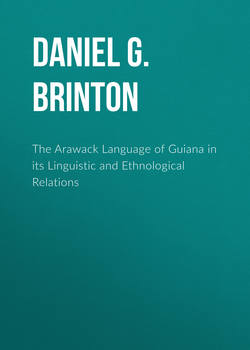Читать книгу The Arawack Language of Guiana in its Linguistic and Ethnological Relations - Daniel G. (Daniel Garrison) Brinton - Страница 2
LANGUAGE
ОглавлениеThe earliest specimen of their language under its present name is given by Johannes de Laet in his Novus Orbis, seu Descriptio Indiæ Occidentalis (Lugd. Bat. 1633). It was obtained in 1598. In 1738 the Moravian brethren founded several missionary stations in the country, but owing to various misfortunes, the last of their posts was given up in 1808. To them we owe the only valuable monuments of the language in existence.
Their first instructor was a mulatto boy, who assisted them in translating into the Arawack a life of Christ. I cannot learn that this is extant. Between 1748 and 1755 one of the missionaries, Theophilus Schumann, composed a dictionary, Deutsch-Arawakisches Wœrterbuch, and a grammar, Deutsch-Arawakische Sprachlehre, which have remained in manuscript in the library of the Moravian community at Paramaribo. Schumann died in 1760, and as he was the first to compose such works, the manuscript dictionary in the possession of Bishop Wullschlägel, erroneously referred by the late Professor von Martius to the first decade of the last century, is no doubt a copy of Schumann’s.
In 1807 another missionary, C. Quandt, published a Nachricht von Surinam, the appendix to which contains the best published grammatical notice of the tongue. The author resided in Surinam from 1769 to 1780.
Unquestionably, however, the most complete and accurate information in existence concerning both the verbal wealth and grammatical structure of the language, is contained in the manuscripts of the Rev. Theodore Schultz, now in the library of the American Philosophical Society. Mr. Shultz was a Moravian missionary, who was stationed among the Arawacks from 1790 to 1802, or thereabout. The manuscripts referred to are a dictionary and a grammar. The former is a quarto volume of 622 pages. The first 535 pages comprise an Arawack-German lexicon, the remainder is an appendix containing the names of trees, stars, birds, insects, grasses, minerals, places, and tribes. The grammar, Grammattikalische Sätze von der Aruwakkischen Sprache, is a 12mo volume of 173 pages, left in an unfinished condition. Besides these he left at his death a translation of the Acts of the Apostles, which was published in 1850 by the American Bible Society under the title Act Apostelnu. It is from these hitherto unused sources that I design to illustrate the character of the language, and study its former extension.1
1
Since reading this article before the Society, Prof. S. S. Haldeman has shown me a copy of a work with the title: “Die Geschichte von der Marterwoche, Auferstehung und Himmelfahrt unsers Herrn und Heilandes Jesu Christi. Uebersetzt in die Aruwackische Sprache und erklärend umschrieben. Philadelphia: Gedruckt bey Carl List, 1799,” 8vo. pages 213, then one blank leaf, then 40 pages of “Anmerkungen.” There is also a second title, in Arawack, and neither title page is included in the pagination. The Arawack title begins: “Wadaijahun Wüüssada-goanti, Wappussida-goanti baddia Jesus Christus,” etc. The remarks at the end are chiefly grammatical and critical, and contain many valuable hints to the student of the language. I have no doubt this book is the Life of Christ mentioned in the text. The name of the translator or editor is nowhere mentioned, but I have no doubt Mr. Schultz wrote the “Anmerkungen,” and read the proof, as not only are his grammatical signs and orthography adopted throughout, but also we know from other sources that he was in Philadelphia at that time.
